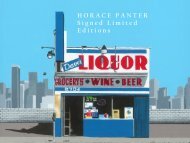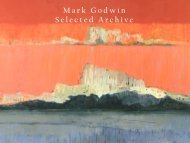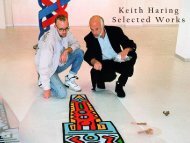Damien Hirst - Selected Works
You also want an ePaper? Increase the reach of your titles
YUMPU automatically turns print PDFs into web optimized ePapers that Google loves.
<strong>Damien</strong> <strong>Hirst</strong> was born in 1965 in Bristol, UK. He lives and works in London and Gloucestershire. Since 1987, over 90 solo <strong>Damien</strong> <strong>Hirst</strong> exhibitions have taken place<br />
worldwide, and he has been included in over 300 group shows. In 2012, Tate Modern, London presented a major retrospective survey of <strong>Hirst</strong>’s work in conjunction with<br />
the 2012 Cultural Olympiad. <strong>Hirst</strong>’s other solo exhibitions include Qatar Museums Authority, ALRIWAQ Doha (2013–2014); Palazzo Vecchio, Florence (2010);<br />
Oceanographic Museum, Monaco (2010); Rijksmuseum, Amsterdam (2008); Astrup Fearnley Museet für Moderne Kunst, Oslo (2005); Museo Archeologico Nazionale,<br />
Naples (2004); Palazzo Grassi and Punta della Dogana, Pinault Collection, Venice (2017), Post Truth, Fake News & Alternative Facts, Haifa Museum, Israel (2019), Villa<br />
Borghese, Rome (2021); Fondation Cartier, Paris (2021) amongst others.<br />
<strong>Hirst</strong> is well-known for his paintings (and handmade editions) such as the series of works with butterflies suspended in thick layers of gloss paint and the ‘Kaleidoscope<br />
Paintings’ where thousands of butterfly wings are arranged in mandala-like patterns. In the ‘Entomology’ paintings from 2013, he revisits this subject-matter again using<br />
butterflies interspersed with thousands of highly coloured insects and spiders to reflect the fragility of life. The corresponding ‘Entomology Cabinets’ utilise the same<br />
components but place them in precise horizontal or vertical rows inside minimal and reflective wall-mounted stainless-steel frames. With each species arranged in<br />
separate rows, the overall effect is one of scientific ordering or industrial production, in part a reference to the Victorian era and its predilection for visual displays that<br />
reflected man's control over nature.<br />
In the ‘Spin’ series, <strong>Hirst</strong> uses a machine that centrifugally disperses the paint as it is steadily poured onto the canvas. The chance spontaneity of the ‘Spins’ stands in<br />
contrast to the more formulaic ‘Spot’ series which have a rigorous grid of uniformly sized dots in different colours. Both series, however, suggest the idea of an imaginary<br />
mechanical painter. Contrastingly, in 2009 <strong>Hirst</strong> embarked on a series of paintings that represented a radical shift, returning to painting alone, what he has described as the<br />
‘most direct form of production, with all the attendant artistic consequences: facing the canvas, the individual painterly act, the creative process, the artist’s emotional<br />
balance – alone; being at the mercy of issues raised by the picture, at the mercy of the creator, of oneself…<br />
’His work features in major collections including the British Museum, The Hirshhorn Museum and Sculpture Garden, the Museum of Modern Art, New York, Tate, the<br />
Stedelijk Museum, the Yale Centre for British Art, The Broad Collection, the Victoria and Albert Museum, Fondazione Prada, and Museo Jumex, among many others.
















